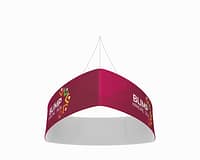University open days are crucial events for prospective students, offering them a glimpse into the vibrant campus life, academic facilities, and community spirit of an institution. As universities strive to create memorable experiences for their visitors, the presentation plays a significant role in leaving a lasting impression. One of the most effective ways to enhance the visual appeal of these events is through the use of fabric banners. These versatile, eye-catching displays not only attract attention but also convey essential information, helping to guide visitors through the campus and immerse them in the university’s culture. In this guide, we will explore how fabric banners can transform university open days and provide essential tips for designing impactful banners.
Transforming University Open Days with Eye-Catching Fabric Banners
Fabric banners can dramatically elevate the atmosphere of a university open day by creating a visually cohesive environment. When designed thoughtfully, these banners serve as an extension of the university’s branding, reinforcing its identity and mission. Whether displayed at entrance points, along pathways, or in key gathering areas, strategic placement of fabric banners can direct foot traffic while enhancing the overall aesthetic of the event. With vibrant colors, stunning graphics, and engaging messaging, fabric banners become focal points that entice prospective students and their families to explore further.
Moreover, fabric banners are lightweight and portable, making them an ideal choice for universities that may need to set up and dismantle displays quickly. Their flexibility allows for creativity in design, with options for various shapes and sizes that can cater to different locations and themes. For instance, a large backdrop banner at the registration area can create a welcoming atmosphere, while smaller banners near specific departments can highlight unique programs and opportunities. This adaptability not only meets practical needs but also enhances the open day’s overall appeal.
In addition to visual impact, fabric banners can foster engagement by incorporating interactive elements. QR codes can be included to direct visitors to digital resources, such as virtual tours or program-specific information. Encouraging prospective students to engage with these digital platforms ensures that the information is not only visible but also accessible. In this way, fabric banners become a vital tool for universities to bridge the gap between physical presence and digital engagement, enhancing the overall open day experience.
Essential Tips for Designing Impactful Fabric Banners
To create fabric banners that leave a powerful impression, it’s essential to prioritize clarity and readability. Potential students and their families may only have a few seconds to absorb the information as they walk by, so the messaging should be concise and impactful. Use large fonts that are easy to read from a distance, and limit the amount of text to key phrases or questions that pique interest. Additionally, consider contrasting colors to ensure that the text stands out against the background. The goal is to communicate the essence of what the university offers at a glance.
Incorporating high-quality images and graphics is another critical aspect of designing effective fabric banners. Images of happy students, campus highlights, and academic settings can evoke emotions and help prospective students visualize themselves as part of the university community. When selecting images, choose those that reflect the diversity and inclusivity of the campus environment. This not only enhances the visual appeal but also signals to visitors that the university values a rich and varied student experience.
Lastly, consistency in branding is vital when designing fabric banners for university open days. Each banner should reflect the university’s established color palette, logo, and overall aesthetic. This coherence strengthens brand identity and fosters a sense of professionalism. Additionally, consider the placement of banners to create a harmonious flow throughout the open day. By strategically positioning banners so they align with key areas of interest, universities can create a cohesive narrative that guides visitors and enhances their overall experience.
In conclusion, fabric banners hold the potential to transform university open days into vibrant, engaging experiences that resonate with prospective students. By leveraging the visual impact of these banners, universities can effectively communicate their brand identity, showcase their offerings, and encourage interaction with visitors. Thoughtful design, clarity, and adherence to branding principles will ensure that these banners not only beautify the campus but also serve a functional purpose in guiding and informing attendees. As universities prepare for their next open day, investing in eye-catching fabric banners can be a game-changer, ultimately helping to attract the next generation of scholars and leaders.



